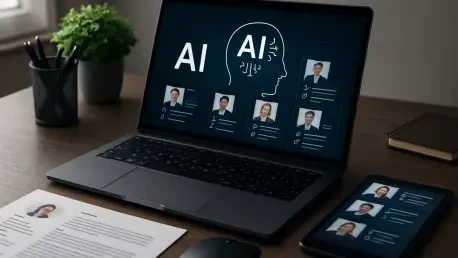Introduction to AI in Recruitment
In an era where talent acquisition faces unprecedented challenges, with millions of job applications flooding organizations annually, AI-driven recruitment tools have emerged as a transformative force in the human resources sector, promising to streamline processes long plagued by inefficiency and subjectivity. These technologies offer a lifeline to recruiters struggling to keep pace with demand. By leveraging advanced algorithms, they aim to redefine how talent is sourced, screened, and selected, setting a new standard for hiring practices.
At the heart of this revolution lie core AI principles such as machine learning and natural language processing, which enable automation of repetitive tasks like resume parsing and candidate communication. These technologies not only enhance speed but also refine accuracy in matching candidates to roles by analyzing vast datasets for patterns that human recruiters might overlook. Their application extends from crafting unbiased job descriptions to scheduling interviews, fundamentally altering the recruitment workflow.
The relevance of AI in addressing persistent challenges cannot be overstated, particularly in combating bias, scaling operations, and improving efficiency within the broader HR technology landscape. Traditional hiring methods often fall short due to unconscious prejudices and manual bottlenecks, but AI offers a pathway to fairness and adaptability. As organizations grapple with diverse applicant pools and societal expectations for equity, these tools stand as a critical component in reshaping talent acquisition for a more inclusive future.
Key Features of AI Recruitment Tools
Bias Detection and Mitigation
AI recruitment tools have introduced sophisticated mechanisms to identify and reduce bias in various stages of hiring, from job advertisements to candidate screening and final selection. By analyzing language in postings for gendered or exclusionary terms, these systems flag potential issues before they reach applicants, ensuring a wider appeal. Additionally, algorithms can prioritize skills over demographic markers, aiming to create a more level playing field.
Features such as blind application reviews and objective scoring systems have shown promising performance in promoting fairness by concealing identifying details like names or ages during initial assessments. These methods focus evaluations on qualifications and competencies, minimizing subjective judgments that often skew decisions. Their ability to standardize criteria across candidates fosters consistency, a cornerstone of equitable hiring practices.
The significance of these bias-mitigation features extends beyond compliance with diversity goals, as they play a vital role in building trust among candidates and stakeholders. When applicants perceive hiring processes as transparent and impartial, confidence in organizational integrity grows. This trust is essential for attracting top talent and maintaining a positive employer brand in competitive markets.
Automation and Efficiency
Automation stands as a hallmark of AI recruitment tools, tackling repetitive tasks that traditionally consume significant recruiter time, such as sifting through thousands of resumes or coordinating interview schedules. By deploying algorithms to filter applications based on predefined criteria, these systems drastically cut down manual effort, allowing HR teams to focus on strategic decision-making. Candidate communication, too, benefits from automated responses that keep applicants informed without delay.
Performance metrics underscore the impact of automation, with notable reductions in time-to-hire and marked increases in recruiter productivity reported across various implementations. Organizations handling large applicant volumes have seen processes that once took weeks shrink to days, enabling faster onboarding of critical talent. Such efficiency gains translate directly into cost savings and improved operational agility for businesses of all sizes.
Real-world examples further illustrate how automation enhances scalability, particularly for companies managing high-volume hiring needs during peak seasons or rapid expansions. Retail giants and tech firms alike have adopted these tools to process surges in applications without sacrificing quality, ensuring no candidate slips through the cracks. This scalability proves invaluable in maintaining competitiveness in dynamic labor markets.
Recent Advancements in AI Recruitment Technology
Innovations in AI recruitment technology continue to push boundaries, with transparent scoring systems and explainable AI features gaining traction among forward-thinking organizations. These advancements allow recruiters to audit decision-making processes by providing clear rationales for candidate rankings or rejections, demystifying the “black box” nature of earlier AI models. Such transparency ensures accountability while aligning with ethical hiring standards.
Emerging trends also include candidate feedback loops and the integration of accessible, inclusive design into recruitment platforms, catering to diverse applicant needs. Tools now often feature adjustable interfaces, captioning for video interviews, and neurodiversity-friendly layouts, reflecting a commitment to accessibility. Meanwhile, feedback mechanisms enable continuous improvement by capturing candidate experiences, refining processes over time.
Shifts in candidate expectations have further shaped these advancements, with a growing demand for transparency and human oversight in AI-driven hiring. Applicants increasingly seek assurance that technology complements rather than replaces personal judgment, prompting developers to embed features that highlight human involvement in final decisions. This balance addresses concerns about over-reliance on algorithms, fostering greater acceptance of AI tools.
Real-World Applications of AI in Recruitment
Across industries, from technology to retail and healthcare, organizations are harnessing AI recruitment tools to optimize talent acquisition strategies. Tech firms leverage these systems for rapid scaling, sifting through global applicant pools to identify niche skills, while healthcare providers use them to address urgent staffing shortages with precision. Retail sectors, facing seasonal hiring spikes, rely on AI to manage volume without compromising candidate fit.
Unique use cases highlight the versatility of AI in hiring, such as skills-based models that prioritize demonstrated abilities over traditional degree requirements, opening opportunities to non-conventional talent. Video interview platforms with inclusive features, like flexible timing and supportive design for neurodiverse candidates, further showcase how technology adapts to varied needs. These applications signal a shift toward more equitable access in employment.
Notable implementations, such as Tribepad’s AI assistant Sidekick, exemplify the practical impact of these tools by balancing automation with human judgment. This system provides explainable scores for candidate evaluations, enabling recruiters to review and adjust outcomes as needed, ensuring fairness. Such examples demonstrate how AI can enhance, rather than dictate, hiring decisions across diverse organizational contexts.
Challenges and Limitations of AI Recruitment Tools
Despite their potential, AI recruitment tools face significant technical challenges, including the risk of unintended bias embedded in algorithms due to flawed training data or design oversights. If historical hiring patterns reflect prejudice, AI may inadvertently perpetuate those inequities, necessitating continuous monitoring and recalibration. This issue underscores the importance of rigorous testing to prevent systemic unfairness.
Candidate mistrust remains another hurdle, fueled by concerns over how diversity data is handled and whether AI can truly replicate human empathy in decision-making. Many applicants question the consistency of automated systems, fearing a lack of personal connection or context in evaluations. Such skepticism can deter talent from engaging with organizations perceived as overly reliant on technology.
Efforts to address these limitations are underway, with transparency initiatives and feedback mechanisms emerging as key strategies to improve fairness and accountability. Developers are increasingly prioritizing explainable AI to clarify decision processes, while organizations encourage candidate input to refine tools. These steps aim to bridge the gap between technological efficiency and the human touch essential for trust in recruitment.
Future Outlook for AI in Recruitment
Looking ahead, the trajectory of AI-driven recruitment tools points toward advancements in ethical AI design, with a strong emphasis on embedding inclusivity features at every stage of development. Algorithms are expected to evolve with enhanced capabilities for detecting subtle biases, while interfaces will likely become even more accessible to diverse populations. This focus on ethics aims to align technology with societal values.
Potential breakthroughs, such as outcome-driven diversity, equity, and inclusion strategies anticipated by 2026, could redefine hiring benchmarks, prioritizing measurable fairness over mere compliance. Innovations may also include deeper integration of AI with human resources systems, enabling seamless tracking of DEI progress across organizational levels. These developments promise to make equity a tangible result rather than an abstract goal.
The long-term impact of AI on workforce dynamics appears poised to foster innovation and resilience, as organizations adopting these tools can better adapt to changing labor needs. Candidate trust, bolstered by transparent practices, will likely become a competitive advantage for companies that master this balance. Ultimately, AI stands to reshape hiring into a more responsive and inclusive process, benefiting both employers and applicants.
Conclusion and Final Assessment
Reflecting on the journey of AI-driven recruitment tools, their strengths in boosting efficiency, curbing bias, and enhancing candidate experiences stand out as transformative. Automation tackled inefficiencies that once bogged down recruiters, while bias detection features laid the groundwork for fairer hiring practices. These advancements marked a significant leap forward in how talent is identified and engaged.
Yet, challenges like algorithmic bias and candidate skepticism persist, casting a shadow over full adoption. The technology, while powerful, requires constant vigilance to ensure it does not replicate past inequities or alienate applicants seeking a human connection. Balancing innovation with empathy emerged as a critical lesson from this era of implementation.
Moving forward, organizations should prioritize integrating transparent AI systems with robust human oversight, ensuring that technology serves as a tool rather than a sole decision-maker. Investing in candidate feedback loops and ethical design will be essential to refine these tools further. As the landscape evolves, fostering trust through clear communication about AI’s role in hiring will remain a vital step toward sustainable, inclusive recruitment practices.









